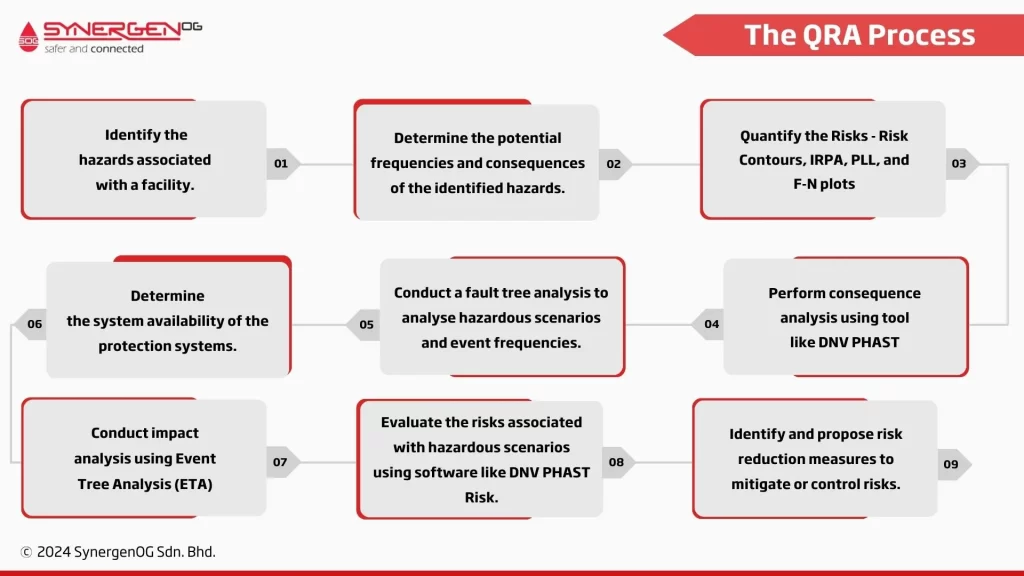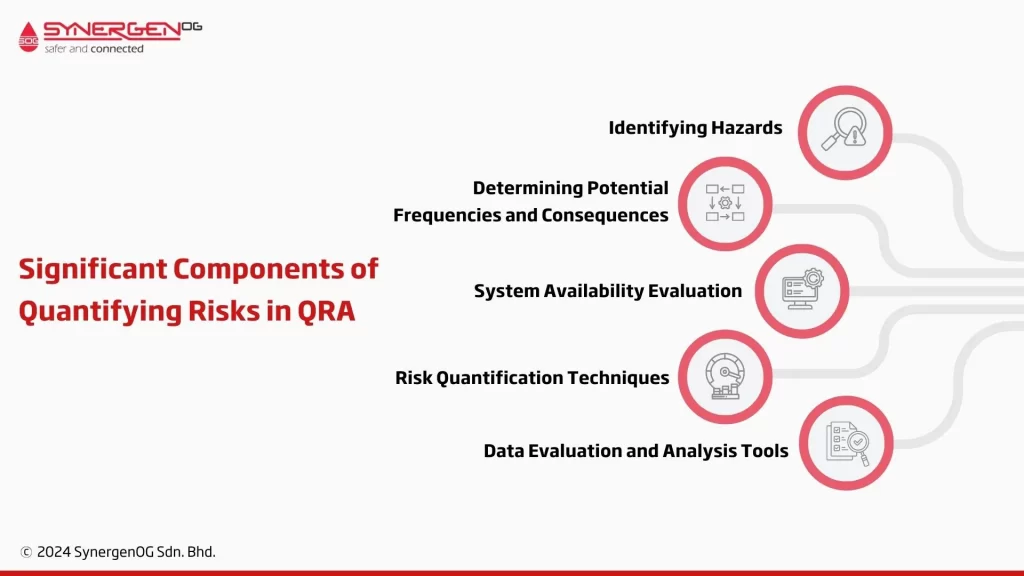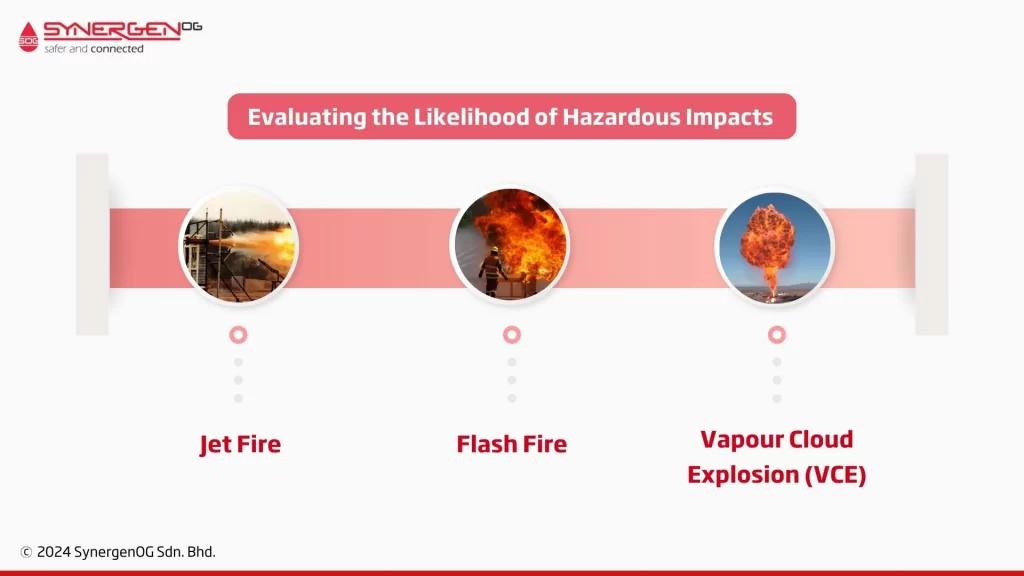| Summary: Discover the role of quantifying and assessing risks in a quantitative risk assessment (QRA). Gain insights into the methodologies, tools, and best practices used to effectively analyze and manage risks. Enhance your risk management strategies with the power of quantitative risk assessment. |
What is a QRA? Quantitative Risk Assessment (QRA) is a systematic and analytical way of figuring out and putting numbers to the risks tied to different dangers and activities in different industrial processes. It uses math, stats, and engineering know-how to dig into and measure risks in a detailed way.
In QRA, we measure and talk about risks using probabilities and consequences. Probabilities tell us how likely something bad might happen, like an event or hazard. On the other hand, consequences show us how severe the impact could be if that event occurs.
By putting numbers to these risks, organisations can figure out how likely incidents are and how bad they might be. This practice helps them make better decisions and take steps to manage those risks.
Importance of quantifying and assessing risks in QRA
The Control of Major Accident Hazards Regulations (COMAH, 1999) mandates operators to mitigate major accidents to ‘as low as reasonably practicable’ (ALARP). QRA in conjunction with cost-benefit analysis (CBA) can economically justify the need for risk reduction measures. This serves as the basis of our exploration into the QRA.
Production and processing facilities, high-pressure pipelines, and storage facilities, including LNG, are usually subject to QRA studies.
QRA allows organisations to make well-informed decisions about how to reduce risks, where to invest resources, and how to plan their operations. It gives a solid numerical basis for evaluating different scenarios, comparing options, and optimising risk management efforts.
When risks are expressed in numbers, organisations can prioritise safety improvements, ensure compliance with regulations, and demonstrate their commitment to responsible risk management to stakeholders, regulatory authorities, and the public.
Understanding the QRA Process

What are the objectives of a QRA Study?
- Identify the hazards associated with a facility.
- Determine the potential frequencies and consequences of the identified hazards.
- Quantify the risks associated with a facility, such as risk contours, individual risk per annum (IRPA), potential loss of life (PLL), and F-N plots.
- Determine the system availability of the protection systems.
- Conduct a fault tree analysis to analyse hazardous scenarios and event frequencies.
- Perform a consequence analysis using tools like Det Norske Veritas (DNV) Process Hazard Analysis Software Tool (PHAST) to determine the consequences of hazardous releases.
- Conduct an impact analysis using event tree analysis (ETA) to determine the likelihood of specific hazardous impacts.
- Evaluate the risks associated with hazardous scenarios using software like DNV PHAST Risk.
- Identify and propose risk reduction measures to mitigate or control risks.
Read: How to Conduct a Process Hazard Analysis: Methods & Steps
Role of Fault Tree Analysis in QRA
Fault Tree Analysis (FTA) is a technique commonly employed in QRA studies to examine the causes and effects of hazardous events. It includes building a logical model, called a fault tree, that illustrates various factors contributing to the occurrence of an undesired event.
FTA assists in pinpointing critical failure modes, assessing their probabilities, and determining their impact on the overall risk assessment.
Consequence Analysis and Impact Analysis in QRA
Consequence analysis is a crucial step in QRA that assesses the potential consequences of hazardous events. It involves evaluating the impacts on human health, safety, and the environment.
Consequence analysis considers factors such as fire, explosion, toxic releases, structural damage, and economic losses. It helps in understanding the severity of a potential incident and guides risk prioritisation and mitigation efforts.
Risk Assessment and Risk Reduction Measures in QRA
Risk assessment in QRA involves evaluating the likelihood of hazardous events and their potential consequences. It typically includes techniques such as quantitative probability analysis, frequency analysis, and risk quantification methodologies.
Risk reduction measures are strategies and actions designed to mitigate or manage identified risks. These may include engineering controls, procedural changes, safety systems, training programs, and emergency response plans.
Lifecycle Cost Analysis in QRA
Lifecycle cost analysis is an essential aspect of QRA that evaluates the costs associated with risk reduction measures over the entire life cycle of a system or project.
This analysis helps in determining the economic feasibility of various risk management options and allows for informed decision-making regarding the allocation of resources for risk reduction.
Significant Components of Quantifying Risks in QRA

1. Identifying Hazards
This stage focuses on identifying and evaluating potential hazards associated with a facility or system. It involves hazard and operability studies (HAZOP), failure modes and effects analysis (FMEA), and a review of historical incidents. By comprehensively identifying hazards, the QRA study can accurately assess the risks involved.
2. Determining Potential Frequencies and Consequences
This step involves conducting a thorough analysis of the facility, considering factors such as design, operational conditions, human factors, and external influences. By quantifying the likelihood of hazardous events and their potential consequences, the study can effectively evaluate and prioritise risks.
3. System Availability Evaluation
The availability and reliability of protective measures or safety systems play a critical role in risk assessment. This component involves evaluating the system’s performance to prevent or mitigate hazardous events. By considering factors like maintenance, test intervals, and failure rates, the QRA study can assess the effectiveness of safety systems in reducing the overall risk.
4. Risk Quantification Techniques
To quantify the risks associated with hazardous events, various techniques and metrics are employed:
- Risk Contours
Risk contours are graphical representations that show the distribution and intensity of risk levels across a given area. These contours provide visual insights into areas with higher or lower levels of risk, aiding in decision-making and priority setting.
- Individual Risk Per Annum (IRPA)
Individual Risk Per Annum (IRPA) quantifies the risk to an individual caused by a hazardous event. It takes into account the frequency and consequence of the event and is often used to determine the acceptability of risk levels for individuals within a specific area.
- Potential Loss of Life (PLL)
The Potential Loss of Life (PLL) metric estimates the number of fatalities that could arise from a hazardous event. It combines event frequencies, consequences, and population data to provide an understanding of the potential human impact.
- F-N Plots
F-N plots display the number of events (F) against their corresponding consequences (N) on a logarithmic scale. This technique helps visualise the relationship between event frequencies and consequences, aiding in risk assessment and decision-making.
5. Data Evaluation and Analysis Tools
Utilising advanced software tools like Det Norske Veritas (DNV) PHAST software is standard in QRA studies. These tools assist in data evaluation, consequence analysis, and risk quantification. For example, the DNV PHAST software allows for comprehensive analysis of hazardous releases and captures essential data to support risk assessments and decision-making.
Assessing Risks in QRA
Evaluating the Likelihood of Hazardous Impacts

Assessing the likelihood of hazardous impacts in a QRA study includes evaluating the potential for various types of incidents:
– Jet Fire
A jet fire occurs when a high-pressure release of flammable gas or liquid ignites, resulting in a high-intensity, turbulent fire. Assessing the likelihood of a jet fire involves analysing the release source characteristics, including the release rate, pressure, and the presence of potential ignition sources.
– Flash Fire
A flash fire occurs when a flammable gas or vapour-air mixture encounters an ignition source, causing a rapidly spreading fire of short duration. To assess the likelihood of a flash fire, the study examines the release characteristics, atmospheric conditions, dispersion patterns, and potential ignition sources.
– Vapour Cloud Explosion (VCE)
A vapour cloud explosion (VCE) is a large-scale explosion resulting from the ignition of a flammable vapour cloud. The QRA study considers factors such as release rates, dispersion conditions, cloud formation, presence of confinement or congestion, and potential ignition sources to evaluate the likelihood of a VCE.
Find More About Fire and Explosion Risk Analysis (FERA)
Risk Assessment Methods and Criteria
Analysing risks in a QRA study involves using advanced software tools like DNV PHAST Risk software and applying risk assessment criteria that aid in identifying and proposing risk reduction measures.
DNV PHAST Risk software combines,
- Hazard identification
- Frequency analysis
- Consequence modelling
It helps in understanding the potential impacts of hazardous events and their likelihood, evaluating various risk metrics, and comparing assessed risks to established criteria. By using the DNV PHAST Risk software, a QRA study can accurately assess risks and facilitate the development of risk reduction measures.
Risk reduction measures are strategies and actions aimed at mitigating identified risks. They may include engineering controls, procedural changes, safety systems, training programs, and emergency response plans. These measures are developed based on the insights gained from the risk assessments and are designed to ensure safety and reduce potential impacts.
How can SynergenOG help you as a QRA Consultant?
SynergenOG provides a global network of consultants who can perform QRA for your projects.
Conclusion
QRA provides all the essential components necessary for an effective risk management system, paving the way for safe, efficient, and sustainable operations.
In conclusion, the process of quantifying and assessing risks in QRA paves the way for well-informed decision-making, cost-effective risk management, and improved overall safety. It represents a significant commitment by an organisation towards protecting employees, the environment, and assets and maintaining regulatory compliance.


[…] Quantifying and Assessing Risks – Quantitative Risk Assessment (QRA) […]
[…] Quantifying and Assessing Risks – Quantitative Risk Assessment (QRA) […]
[…] Quantifying and Assessing Risks – Quantitative Risk Assessment (QRA) […]
[…] Quantifying and Assessing Risks – Quantitative Risk Assessment (QRA) […]
[…] Quantifying and Assessing Risks – Quantitative Risk Assessment (QRA) […]
[…] Quantifying and Assessing Risks – Quantitative Risk Assessment (QRA) […]
[…] Quantifying and Assessing Risks – Quantitative Risk Assessment (QRA) […]